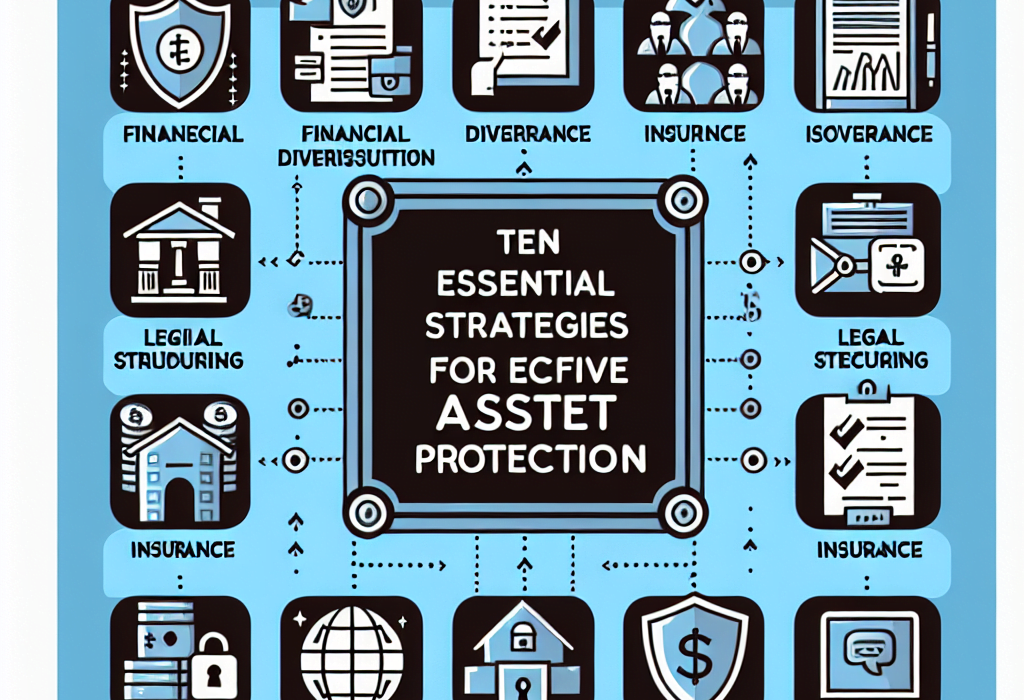Asset protection, a vital part of financial planning, is a legal form of wealth protection aimed at safeguarding one’s assets from lender claims and lawsuits. It is about taking preemptive action to protect your hard-earned assets from risks. It is about ensuring that even if you were to come against a financial storm, your assets would be secure. It is thus essential to understand and implement effective asset protection strategies. This article explores ten strategies for effective asset protection.
1. Create an Asset Protection Plan
First and foremost, creating an asset protection plan is pivotal to safeguarding your wealth. This plan should be comprehensive, achieving a balance between securing your assets and minimizing risk exposure. It means knowing what to protect, understanding your risk profile, and developing methods to safeguard your wealth effectively. A comprehensive asset protection plan is not just about shielding wealth but also ensuring it can withstand any potential lawsuit or creditor claims.
2. Understand the different forms of asset ownership
Asset ownership forms a pivotal part of asset protection. Every form of asset ownership comes with its risks, and understanding these risks will help you leverage the best possible protection for your assets. Examples of ownership forms include sole ownership, joint ownership, contractual relationships, corporations, partnerships, trusts, and limited liability companies (LLCs).
3. Leverage professional help
Asset protection is a complex field necessitating professional help. Often, this necessity is overlooked due to the costs associated with professional advice, leading to poor asset protection strategies and potentially huge losses. Procuring professional help from lawyers, financial planners, and tax consultants can provide a holistic view of your assets and advise on optimal protection strategies.
4. Maintain good insurance policies
The cornerstone of any successful asset protection strategy is good insurance. Insurance provides the first line of defense against any unforeseen liabilities. It not only protects your assets but also your income, providing you with peace of mind knowing that you are covered, financially speaking.
5. Incorporate or establish an LLC
Incorporating or establishing an LLC offers significant advantages, primarily in creating a legal distinction between personal and business assets. Essentially, it separates your personal and business wealth, protecting your personal assets from any business liabilities or litigation. Moreover, forming an LLC or a corporation grant tax benefits and operation flexibility, enhancing your asset protection strategy.
6. Establish asset protection trusts
Asset protection trusts can provide a secure way to safeguard your assets from creditors. The trust legally owns the assets, and you, as the beneficiary, can still enjoy the benefits of these assets. It minimizes the risks associated with lawsuits by making assets unattractive and challenging to reach for plaintiffs.
7. Maximize contributions to retirement accounts
Retirement accounts offer excellent asset protection benefits. Most retirement accounts are equipped with legal protections against creditors, making them an ideal part of an asset protection strategy. Therefore, it is wise to maximize contributions to such accounts.
8. Utilize homestead exemptions
Where applicable, utilizing homestead exemptions within an asset protection strategy can protect your primary residence from creditors. This law varies widely from state to state, and so it is crucial to understand the criteria and caps applicable in your particular state.
9. Adopt foreign asset protection strategies
Incorporating foreign asset protection strategies, such as creating foreign trusts or overseas accounts, can offer an added layer of protection. It would be best to explore this strategy with a professional accustomed to international tax laws and asset protection.
10. Avoid fraudulent transfers
Avoiding fraudulent transfers is not just a sound asset protection strategy, it is also a legal obligation. Engaging in such action can lead to severe legal consequences. Therefore, regularly reviewing and updating your asset protection plan can help minimize such risks.
To wrap up, asset protection takes a comprehensive approach that requires a strong understanding of various businesses and financial aspects. The strategies outlined are techniques used to protect assets from potential creditors. It is not an assurance of absolute protection but can put you in a stronger position if you ever face a financial storm. It is always recommended to seek professional advice when determining your asset protection strategy to ensure you are well protected.
1. When is the best time to start asset protection planning?
It is recommended to start your asset protection planning as soon as possible. The most effective strategies work best when implemented long before any financial storm hits.
2. Can insurance provide adequate asset protection?
While insurance is a crucial component of asset protection, it is not alone sufficient. Other strategies such as incorporating or forming an LLC, establishing trusts, and segregating personal from business assets are also important.
3. How does a professional asset protection planner help?
A professional asset protection planner can help you understand your potential risks and develop a suitable protection plan. They can help you navigate complex laws, ensuring all your strategies are legal and effective.
4. Are foreign asset protection strategies illegal?
No, as long as they are properly set up and managed in accordance with international law. It is essential to seek legal advice when setting up foreign trusts or accounts.
5. How can I protect my assets from creditors?
There are several ways you can protect your assets from creditors, some of which include establishing an LLC, insurance, trusts, maximizing retirement contributions, utilizing homesteading exemptions, and exploring foreign asset protection strategies. It is always important to engage a professional when developing an asset protection strategy.













